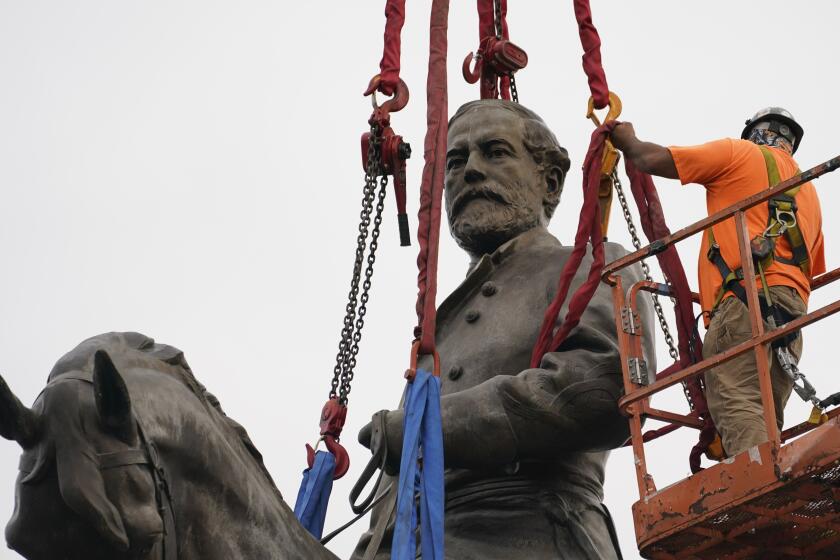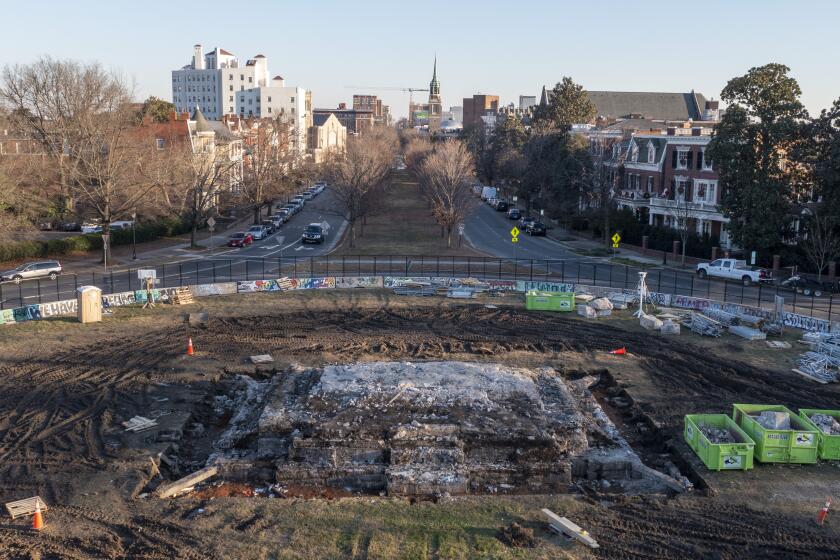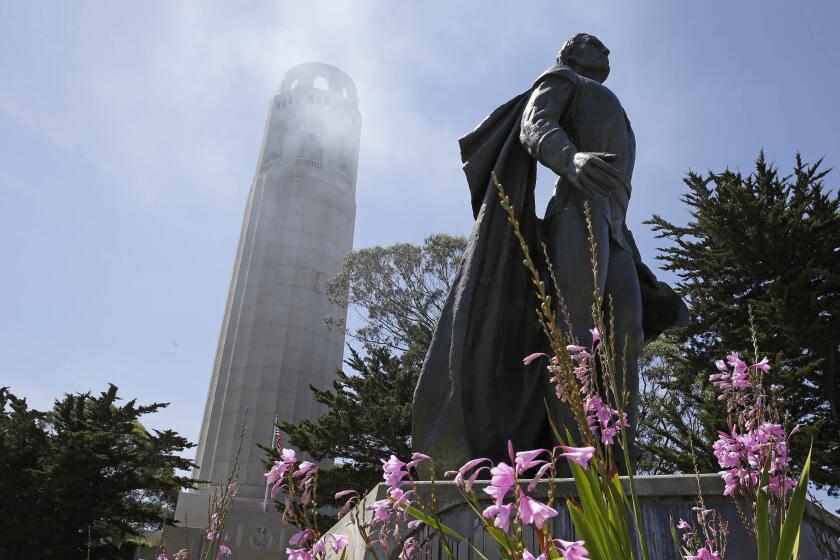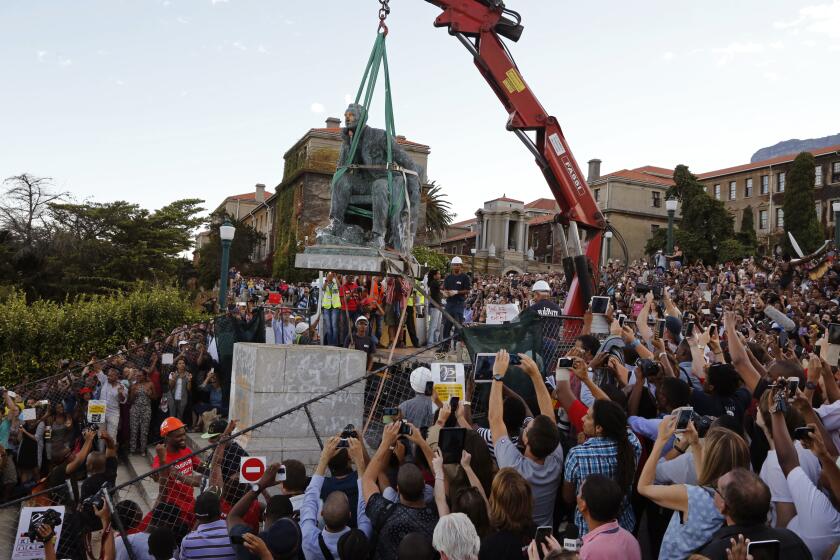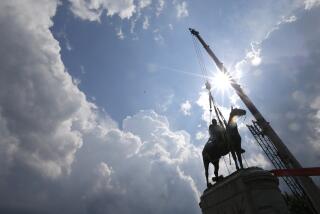Reckoning over race and history turns its focus to roadside historical markers

- Share via
HARRISBURG, Pa. — Pennsylvania had been installing historical markers for more than a century when the racist violence in Charlottesville, Va., in August 2017 brought a fresh round of questions from the public about just whose stories were being told on the state’s roadsides — and the language used to tell them.
The increased scrutiny helped prompt a review of all 2,500 markers by the Pennsylvania Historical and Museum Commission, a process that has focused on factual errors, inadequate historical context and racist or otherwise inappropriate references.
So far, the state has removed two markers, revised two and ordered new text for two others.
Across the country, historical markers have in some places become another front in the national reckoning over slavery, segregation and racial violence that has also brought down Civil War statues and changed or reconsidered the names of institutions, roads and geographical features.
The idea that “who is honored, what is remembered, what is memorialized tells a story about a society that can’t be reflected in other ways” is behind an effort by the Montgomery, Ala.-based Equal Justice Initiative that has installed dozens of markers, mostly in the South, to remember racial terror lynchings.
Historical markers educate the public and therefore can help fight systemic racism, said Diane Turner, curator of the Charles L. Blockson Afro-American Collection at Temple University in Philadelphia, one of the country’s largest repositories of Black history literature and related material.
Crews remove one of the country’s largest remaining monuments to the Confederacy, a towering statue of Gen. Robert E. Lee in Richmond, Va.
“By being able to tell everybody’s story, it’s good for the society as a whole. It’s not to take away from anybody else,” Turner said. “Let’s have these stories, because the more truth we have, the better it is.”
At the request of Bryn Mawr College’s president, Kimberly Wright Cassidy, the Pennsylvania history agency removed a marker from the edge of campus noting that Woodrow Wilson had briefly taught there. Cassidy’s letter to the commission cited the former U.S. president’s dismissive comments about the intellectual capabilities of women and his racist policy of federal workforce segregation.
The commission has ordered changes to a marker at the suburban Philadelphia birthplace of Continental Army Maj. Gen. “Mad” Anthony Wayne, which referred to him as an “Indian fighter.” The commission is also developing a replacement for a marker that has been removed from the grounds of the National Aviary in Pittsburgh, on the site of a 19th-century prison. The marker had noted that Confederate cavalry were held there after their capture in Ohio during the Civil War.
State officials took down a marker in Pittsburgh’s Point State Park noting the location where British Gen. John Forbes had a 1758 military victory that the marker said “established Anglo-Saxon supremacy in the United States.”
Virginia Gov. Ralph Northam says crews wrapping up the removal of a giant pedestal that once held a statue of Confederate Gen. Robert E. Lee find time capsule.
The commission also revised two markers in central Pennsylvania’s Fulton County — one related to the movement of Confederate Army troops after the Battle of Gettysburg in 1863 and the other related to an 1864 Confederate cavalry raid on Chambersburg that left much of the town a smoldering ruin.
The former previously described the last Confederates to camp on Pennsylvania soil; the state has since added language about their defeat by Union troops. The latter marker, about two Confederates killed in a skirmish, was revised to include details of their raid and how Union soldiers from New York killed them and took 32 prisoners.
The changes have generated some political pushback, including from a Republican state representative, who is an appointee to the Historical and Museum Commission. He wrote in October about his objections to the initiative.
“My fear is that the commission is becoming less of a true historical arbiter and more of a miniaturized version of George Orwell’s Ministry of Truth that has government officers alter history to fit the convenient narrative of those in charge,” state Rep. Parke Wentling wrote.
A monument, which has been repeatedly defaced, was removed early Thursday morning and placed in storage, officials said.
In a report to the commission, a contractor recounted that an elected Fulton County commissioner harassed his team when it removed the old markers last year.
And this month, a press aide to a senior Republican in the state House responded to a news account about the Fulton County markers with a tweet saying: “Is Pennsylvania planning to remove ‘The Confederacy’ from textbooks? Censor TV shows and movies mentioning ‘The Confederacy?’”
Disputes about how historical markers should be worded — or whether they should exist at all — have divided communities in other states in recent years, including in Memphis, Tenn.; Sherman, Texas; and Colfax, La.
In Pennsylvania, the commission examined all of the 2,500 markers it controls with a focus on how African American and Native American lives and stories are portrayed, and adopted a new policy on how markers are established. About a year ago, it identified 131 existing markers that may require changes, including a subgroup of 18 that required immediate attention.
News Alerts
Get breaking news, investigations, analysis and more signature journalism from the Los Angeles Times in your inbox.
You may occasionally receive promotional content from the Los Angeles Times.
“The language could be sexist, it could be racist, it could be all those different things,” said Jacqueline Wiggins, a retired educator from Philadelphia on the state historical commission’s Marker Review Panel. “There’s work to be done.”
Of the new markers receiving approval, a rising number tell the stories of previously underrepresented people and groups.
The commission is offering financial support for the markers if their subjects concern women, Latinos and Asian Americans, or if they are about Black and LGBTQ history outside Philadelphia. Financial support is also being provided to underrepresented regions. Last year, the agency subsidized markers on petroglyphs in Clarion County, a camp where Muhammad Ali trained in Schuylkill County and the site of a boycott that stopped a school segregation effort in Chester County.
New markers approved in March include ones that note the first substantial workforce of Chinese immigrants in the state at a cutlery factory, the co-founder of one of the country’s first Black fraternities and three Ephrata women who are among the nation’s first documented female composers.
Likenesses of Queen Victoria, Cecil Rhodes and King Leopold, symbols of colonial rule in Africa, have been taken down on the continent they exploited.
Native American-related markers generally frame the Indigenous people in terms of the Europeans who displaced them, such as a Juniata County marker about “a stockade built about 1755 to protect settlers from Indian marauders.”
“There is a lot of tap-dancing over who initiated which battle or skirmish,” said historian Ira Beckerman, who recently produced a study focused on Pennsylvania markers that relate to Black and Native American history. “If the settlers started it, it was a battle and therefore worthy. If the Native Americans responded in kind, it was a massacre, savagery, etc.”
Beckerman concluded that, as a whole, the state’s 348 Native American historical markers “tell a pretty accurate and compelling story of racism and white nationalism.”
More to Read
Sign up for Essential California
The most important California stories and recommendations in your inbox every morning.
You may occasionally receive promotional content from the Los Angeles Times.
